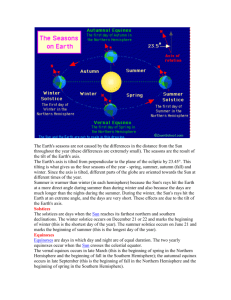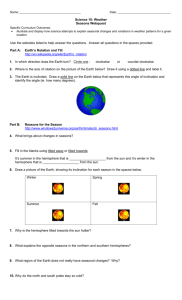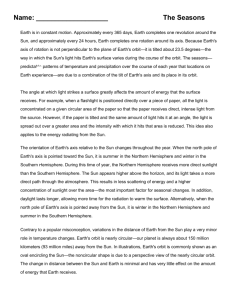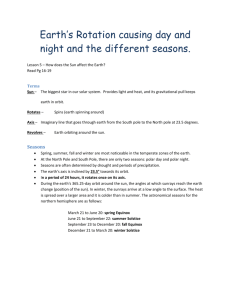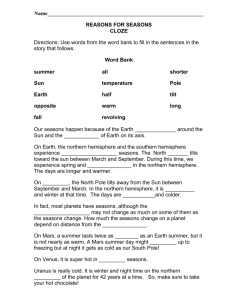Change of Seasons
advertisement
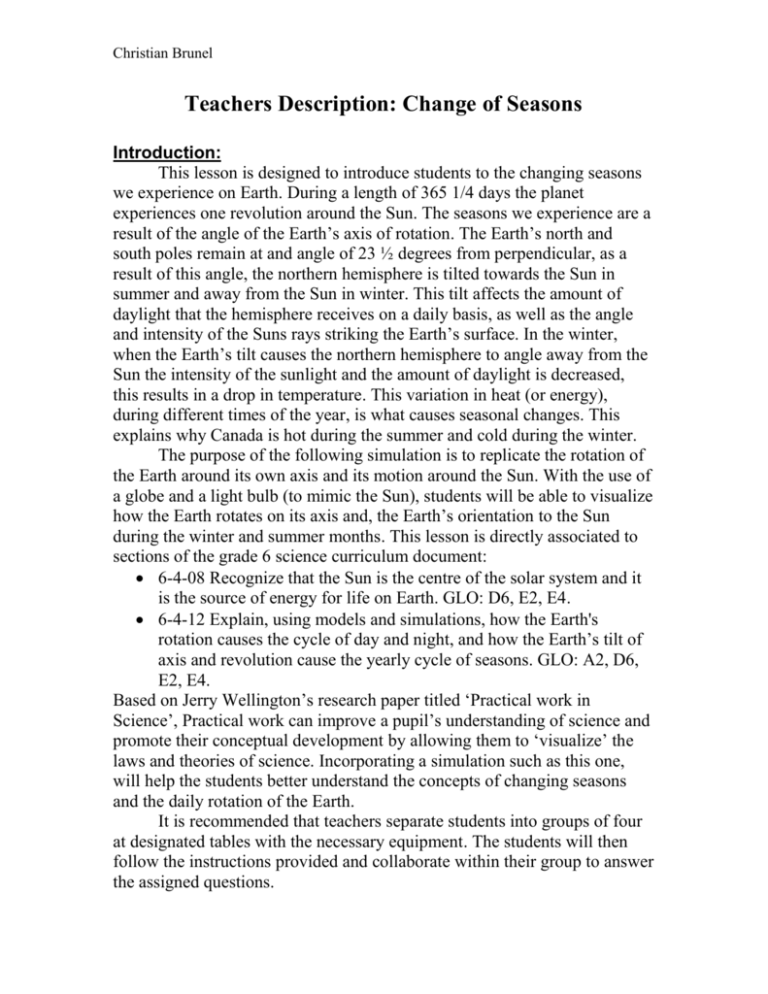
Christian Brunel Teachers Description: Change of Seasons Introduction: This lesson is designed to introduce students to the changing seasons we experience on Earth. During a length of 365 1/4 days the planet experiences one revolution around the Sun. The seasons we experience are a result of the angle of the Earth’s axis of rotation. The Earth’s north and south poles remain at and angle of 23 ½ degrees from perpendicular, as a result of this angle, the northern hemisphere is tilted towards the Sun in summer and away from the Sun in winter. This tilt affects the amount of daylight that the hemisphere receives on a daily basis, as well as the angle and intensity of the Suns rays striking the Earth’s surface. In the winter, when the Earth’s tilt causes the northern hemisphere to angle away from the Sun the intensity of the sunlight and the amount of daylight is decreased, this results in a drop in temperature. This variation in heat (or energy), during different times of the year, is what causes seasonal changes. This explains why Canada is hot during the summer and cold during the winter. The purpose of the following simulation is to replicate the rotation of the Earth around its own axis and its motion around the Sun. With the use of a globe and a light bulb (to mimic the Sun), students will be able to visualize how the Earth rotates on its axis and, the Earth’s orientation to the Sun during the winter and summer months. This lesson is directly associated to sections of the grade 6 science curriculum document: 6-4-08 Recognize that the Sun is the centre of the solar system and it is the source of energy for life on Earth. GLO: D6, E2, E4. 6-4-12 Explain, using models and simulations, how the Earth's rotation causes the cycle of day and night, and how the Earth’s tilt of axis and revolution cause the yearly cycle of seasons. GLO: A2, D6, E2, E4. Based on Jerry Wellington’s research paper titled ‘Practical work in Science’, Practical work can improve a pupil’s understanding of science and promote their conceptual development by allowing them to ‘visualize’ the laws and theories of science. Incorporating a simulation such as this one, will help the students better understand the concepts of changing seasons and the daily rotation of the Earth. It is recommended that teachers separate students into groups of four at designated tables with the necessary equipment. The students will then follow the instructions provided and collaborate within their group to answer the assigned questions. Christian Brunel Change of Seasons Worksheet What causes the change of seasons? We will continue our study of the solar system today with a simple simulation of the earth’s rotation around the sun. This simulation will clearly demonstrate the change of seasons we experience in Winnipeg, Manitoba and what causes day and night. We know that it takes the earth 365 days (1 year) for the earth to make one full trip around the sun. By the end of the class, we will all understand what causes winter, summer, night and day. We have 35 min. to complete this worksheet, followed by a class discussion to review the answers. Follow the steps and answer the questions in the following worksheet. Step 1: Select one member of your table group to retrieve a globe, light bulb and one erasable marker from the front of the class. Place the globe in the middle of the table and place the bulb on your textbook approximately 1 arms length away. Step 2: Locate Winnipeg on the globe and mark it using the marker you have retrieved. Rotate the globe so Winnipeg is angled away from the sun but is in the light. The imaginary line that the Earth Rotates around is called its axis. Question 1: Now that you have found Winnipeg, is it located in the northern or southern hemisphere of the globe? _______________________. Question 2: What is the name given to the line that separates the northern and southern hemisphere? ______________________. Step 3: Rotate the Earth 180 degrees on its axis (so Winnipeg is not in the light). Now rotate the earth another 180 degrees, back to the original location with Winnipeg in the sun. We have just represented 24 hours, or one full rotation around the Earth’s Axis. Step 4: Pick up the globe and place it on the other side of the sun with Winnipeg in the dark, but the northern hemisphere angled towards the sun Christian Brunel Step 5: Rotate the Earth 180 degrees on its axis (so Winnipeg is in the light). Now rotate the earth another 180 degrees, back to the original position. We have just represented another 24 hours. Question 3: Now that you have demonstrated 24 hours using the globe and sun, what causes the change between night and day? A) Rotation of the Earth on its Axis. B) Rotation of the Earth around the sun. C) Rotation of the sun around the Earth. Question 4: Did the angle of the Earth’s axis change between step 3, 4, or 5(is the Earths’ North Pole still pointed in the same direction)? _________. Question 5: If it takes 365 days for the Earth to rotate around the Sun, how many days did we simulate by moving the Earth to the opposite side of the Sun? ____________________. It is important for us to understand that the Earth gets its energy from the Sun. Therefore, the more sunlight a particular part of the Earth receives, the more energy it gets. It can result in that part of the Earth receiving a warmer climate during this time. Question 6: Is Winnipeg in the Sun longer in step 5 or step 3? ______. What step represents summer, and what step represents winter? How can you tell? ______________________________________________________ ______________________________________________________ ______________________________________________________ (Hint - Is Winnipeg in the daylight longer in the summer or winter?) Question 7: If it is summer in the northern hemisphere, what season is it in the southern hemisphere? _________________ Demonstrate why, using the globe and light bulb.

